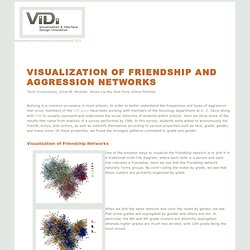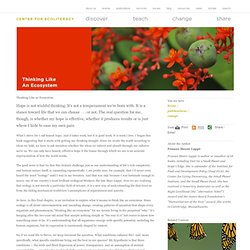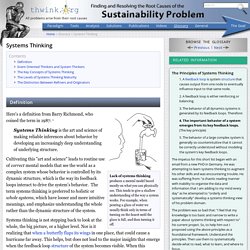

World-Bridger Design » Sweet Tools, Frameworks and Resources for Making Change » World-Bridger Design. Go-go-gadget manic archivist! This list will be updated periodically. Because life goes on. Aggression Networks. Tarik Crnovrsanin, Chris W.

Muelder, Kwan-Liu Ma, Bob Faris, Diane Felmlee Bullying is a common occurance in most schools. In order to better understand the frequencies and types of aggression that occur, members of the VIDi group have been working with members of the Sociology department at U. C. Honey Bee Extinction. Given all of the interest in AG these days, perhaps we should look at something that might lead to some extreme scarcity: Honey Bees.

Or more specifically, the decreasing number of them. Honeybees-full.png (940×3284) Colony collapse disorder. Honey bees at a hive entrance; one is about to land and the other is fanning.

Colony collapse is significant economically because many agricultural crops worldwide are pollinated by European honey bees. According to the Agriculture and Consumer Protection Department of the Food and Agriculture Organization of the United Nations, the worth of global crops with honeybee’s pollination was estimated to be close to $200 billion in 2005.[7] Shortages of bees in the US have increased the cost to farmers renting them for pollination services by up to 20%.[8] The mechanisms of CCD and the reasons for its increasing prevalence remain unclear, but many possible causes have been proposed: pesticides (in particular, those of the neonicotinoid class); infections with Varroa and Acarapis mites; malnutrition; various pathogens; genetic factors; immunodeficiencies; loss of habitat; changing beekeeping practices; or a combination of factors.[9] History[edit] Signs and symptoms[edit] North America[edit]
Thinking Like an Ecosystem. Ecoliteracy.org Thinking Like an Ecosystem Hope is not wishful thinking.

It's not a temperament we're born with. It is a stance toward life that we can choose . . . or not. The real question for me, though, is whether my hope is effective, whether it produces results or is just where I hide to ease my own pain. What I strive for I call honest hope. The good news is that we face this historic challenge just as our understanding of life's rich complexity, and human nature itself, is expanding exponentially. So here, in this final chapter, is an invitation to explore what it means to think like an ecosystem.
So, if we want life to thrive, we keep foremost the question, What conditions enhance life? Shifting from the mechanical assumption of separateness and seeing our societies as ecosystems, we get curious about how aspects interact. The implication? It's the context, stupid! Thinking like an ecosystem means seeing everything in context, or at least giving it our best shot. Glossary: Systems Thinking. Definition Lack of systems thinking produces a mental model based mostly on what you can physically see.

This tends to give a shallow understanding of the way a system works. For example, when pouring a glass of water we usually think only in terms of turning on the faucet until the glass is full, and then turning it off. Here's a definition from Barry Richmond, who coined the term in 1987: Systems Thinking is the art and science of making reliable inferences about behavior by developing an increasingly deep understanding of underlying structure. Cultivating this "art and science" leads to routine use of correct mental models that see the world as a complex system whose behavior is controlled by its dynamic structure, which is the way its feedback loops interact to drive the system's behavior.
Systems thinking is not stepping back to look at the whole, the big picture, or a higher level. What System? The pop-culture application of systems thinking and chaos theory is described as the Butterfly Effect -- how tiny variations can affect giant and complex systems, like weather patterns.

The term "Butterfly Effect" suggests that wing movements of a butterfly might have significant repercussions on wind strength and conditions throughout the weather systems of the world, and theoretically, could cause tornadoes halfway around the world. The implication? The prediction of any large system's behavior is virtually impossible without accounting for a multitude of tiny factors -- surely too many to account for -- any one of which might have a minute but significant effect on the system. Understanding systems, their interactions and changes allows leaders to establish and maintain a focus on process and to achieve organizational strategy. Peter Senge is an influential systems thinker.
Senge's 11 Laws of Systems. Education for Sustainability. Core Ecological Concepts. Understanding the patterns and processes by which nature sustains life is central to ecological literacy.

Fritjof Capra says that these may be called principles of ecology, principles of sustainability, principles of community, or even the basic facts of life. A Systems Perspective. Systems thinking presents a different lens through which to understand the complexity of the world.

Thinking systemically entails a number of shifts in perception, which lead to different ways to teach, and to different ways to organize institutions and society. These shifts offer opportunities for teachers to present material in more holistic ways, in context rather than as isolated facts, consistent with the way students encounter the natural and social worlds in their own experience.